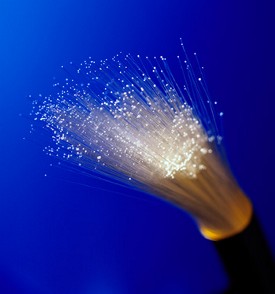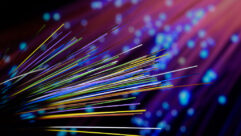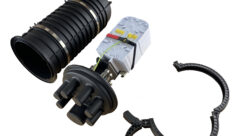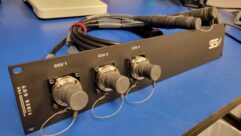

Fiber: Truth or Fiction?
Fiber-optic cabling has become big business. In recent years, fiber’s advantages over copper Cat-X and coaxial wiring have become clearer to a larger number of AV systems integrators. Still, misconceptions persist and it can be hard for integrators, installers, and end users to separate hype from reality. We gave it a shot.
Fiber-optic cabling has become big business. The gross value of fiber cable used in the U.S. this year has reached $1.9 billion, according to market research publisher Supplier Relations’ 2009 sector analysis report. That’s up 30 percent from a separate U.S. Census Bureau report just a few years ago. This shouldn’t come as a surprise: In recent years, fiber cabling’s advantages over copper category-X and coaxial wiring, under the right circumstances, increasingly have become more clear to a larger number of systems integrators. Fiber offers the ability to carry much more information and deliver it with greater fidelity than either twisted pair wire or coaxial cable. Fiber’s immunity to all kinds of EMP and RF interference adds a measure of reliability to applications. And fiber, because it’s composed of glass strands, is highly resistant to corrosion.
Moreover, fiber isn’t the Mercedes-Benz of structured wiring any more. Fiber-optic cabling costs have come down significantly in recent years, an effect that’s been enhanced by the rise in copper prices in the surging commodities markets. Fiber today costs around 25 cents or less per meter, virtually on-par with copper–22 cents per meter at press time.
Finally, there are other, sometimes less apparent, benefits of fiber. Fire code regulations often require the use of plenum-rated cable in certain AV installations, which can add as much as a 100-percent premium over the cost of standard coax and Cat-5 cables. On the other hand, plenum-rated fiber cabling carries only a 10-percent premium (often less) over standard PVC cable. Sure, copper may still cost less than fiber linearly, but when measured by capacity, fiber comes out on top.
Fiction
It’s not easy to learn what I need to about fiber
That might have been the case up until a few years ago, but the number of resources integrators can use to educate themselves is growing quickly. “We struggled with this same topic for the last few years,” says Jim Scrivner, senior product marketing manager at Extron.
Scrivner says that trade organizations, InfoComm in particular, have incorporated classes on fiber use in their training curricula. InfoComm currently offers a free eight-part online presentation on fiber (find it by going to www.proavmagazine.com/infocommfiber), among other resources. Third-party training is offered by a growing cadre of regional and national training companies, such as Light Brigade, which offers both two- and four-day sessions in various cities as well as lessons on DVD.
But manufacturers in the fiber-optic space are also stepping up their educational efforts, such as instructional videos on Corning’s website (www.corning.com/opticalfiber/library), and Extron’s own Extron Institute Schools (www.extron.com/education). Communications Specialties also runs a popular series of FiberEd seminars and publishes detailed guides and application briefs (start at www.commspecial.com/education/fiber-ed).
“Lack of training and availability of information is no longer a reason not to move into fiber,” says Scrivner.
So why doesn’t everyone run fiber? Sure, it’s not always the right solution for the job, although that hurdle is becoming lower and lower. The fact is, misconceptions about fiber cabling still exist among systems integrators. And sometimes, those who are educating the industry are at odds with each other. Hey, in some ways we’re all still learning here. So PRO AV called around to assess the truthfulness of what integrators keep hearing in the market. Truth or fiction:
“Fiber requires special skills to work with and troubleshoot”
The transition from copper to fiber is in some ways a fairly small jump as they’re both cables that channel a signal. But in other ways, the differences are significant–coax and Cat-5/6 channel electricity, while fiber channels light.
“Fiber is cut-and-dried; it either works or it doesn’t. It’s much less ambiguous than copper from a troubleshooting point of view,” says Derek Miranda, director of marketing for manufacturer Communications Specialties Inc. (CSI). Basically, anything that lets light seep out of the cable can diminish the power level of the signal, which is measured in decibels (dB). An optical power meter, which measures the strength of the signal, can help troubleshoot most fiber installations. Since fiber’s distance capabilities are rated in kilometers (fiber specifications in general tend to be expressed in metric rather than the imperial values used for copper and Cat-5/6, another common source of confusion), the much shorter runs typical for most AV applications mean that signal strength is rarely a problem.
Another concept unique to fiber is the loss budget, which determines the distance a wire run can go before it requires a boost from an optical distribution amplifier. Loss budgets in the 20-percent to 30-percent range are not unusual. (Download a Pro AV Cheat Sheet on measuring loss here
.)
What copper wiring requires that fiber does not are equalization and de-skewing, in order to correct the synchronization of signals arriving at a destination, such as a video display. “There are no de-skewing [devices] or equalizer trimmers the way you find on copper products,” Miranda explains. “Fiber products are plug-and-play. There’s no configuration to be done.”
“Fiber cabling is difficult to connect and terminate”
Many people have reservations about “connectorizing” fiber-optic cable based on problems they have heard concerning the “grinding and polishing” of glass. The reality is that this now takes less than a minute and is done within a simple tool. Once one is completely familiar with the process (which takes 30 minutes to an hour to learn), the longest time interval involved in the finishing process is waiting for epoxy to cure. “It is at least as easy to do as terminating a BNC on coax, and some of those who have done it will say it is even easier,” Miranda says.
Several connector manufacturers offer “quick-crimp” optical connectors that are installed with various mechanical clamp arrangements and hot-melt or instant-bond adhesives. Some of these connectors, such as the Corning Unicam Connector System, even come with a pre-polished length of optical fiber in the tip, thereby eliminating the finishing step altogether. The main difference between connector systems is in the mechanical way that the connectors mate to each other. (Download a PRO AV Cheat Sheet on terminating fiber here
.)
“Fiber can be dangerous to work with”
Because the only signal in the fiber cable is light, there is no possibility of a spark from a broken fiber, eliminating the risk of fire and electrical shock hazards for integrators and end users. However, looking directly into the business end of an illuminated fiber cable can cause permanent damage to the rod and cone photo receptors in the eye’s retina, warns Chris Mitchell, general manager of TexelSPL, the structured cabling business division of integrator AVI-SPL.
Furthermore, Mitchell adds, users need to remember that communications fiber is made of Acrylite-coated glass. When it’s broken in the process of terminating or cleaving, microscopic glass shards can result that need to be handled with care. “If you use compressed air to clean an area that has these shards, you run the risk of them getting into your eye, something that could require surgery to fix,” Mitchell says, referring to a personal experience that happened to him 25 years ago, when fiber was still a fairly exotic cable.
“Multimode is the same as single-mode fiber, but with more capacity”
Intuitively it seems correct, but it isn’t. Multimode actually has less capacity than single-mode fiber. Single-mode fiber is a single strand of glass fiber with a diameter of 8.3 to 10 microns that has one mode of transmission, which typically propagates at 1310 or 1550 nanometers (nm). It carries higher bandwidth than multimode fiber, but requires a light source with a narrow spectral width.
Multimode fiber also uses a single strand of glass fiber, but it has a different composition that scatters light into multiple modes (i.e., beams of light). This limits multimode fiber’s bandwidth and distance. Jim Jachetta, senior vice president at MultiDyne Video & Fiber Systems, suggests the following analogy: “Multimode is like firing a shotgun down a conduit–you get a lot of pellets into it, but they tend to bounce off the walls so they don’t go very far and aren’t completely accurate. Single-mode fiber is like firing a rifle down the conduit–it’s just a single bullet but it will go straighter, faster, and farther than the pellets.”
Single-mode fiber offers a higher transmission rate and up to 50 times more distance than multimode. Multimode fiber can provide high bandwidth at high speeds (up to 4Gbps) but only over short distances. And in cable runs greater than 1,500 feet, multiple modes (beams) of light can cause signal distortion at the receiving end, resulting in an unclear and incomplete data transmission.
But even this distinction can be somewhat blurry, giving rise to yet another misconception about fiber, namely that multimode fiber is for multiple signals and single-mode fiber is for a single signal.
Both multimode and single-mode fiber can transport multiple signals if they are time-division multiplexed together into one wavelength. In addition, multiple wavelengths can be optically multiplexed onto one fiber using wave-division multiplexing (WDM) and coarse wave-division multiplexing (CWDM). This WDM technique is used in telecom and IT applications for single-mode fiber but has been uncommon in the AV space until now. Jachetta says up to 18 wavelength channels on single-mode and multimode fiber is becoming more common in pro AV applications.
“The latest advancements in wave-division multiplexing now offer CWDM solutions over multimode fiber,” he says. “We have completed several projects using CWDM technology over multimode fiber.”
Fiber: Truth or Fiction?
Fiber-optic cabling has become big business. In recent years, fiber’s advantages over copper Cat-X and coaxial wiring have become clearer to a larger number of AV systems integrators. Still, misconceptions persist and it can be hard for integrators, installers, and end users to separate hype from reality. We gave it a shot.
“Fiber is signal-agnostic”
This is true in the sense that it will carry any type of signal, but integrators have to be aware that the signal itself can be proprietary, requiring the use of the same manufacturer’s equipment at all terminations. That’s contributed to a sense among AV integrators that standards don’t exist for fiber transmission. “Down the road a fiber-optic standard will probably emerge,” says Drake Wayson, president of national systems integrator General Projection Systems, based in the Orlando, Fla., area. “In the meantime, you have to think ahead about what kind of connectors are on the devices and stick with one brand for the entire facility.”
But while Miranda acknowledges that AV integrators do have to be aware of proprietary differences between manufacturers’ termination devices, he also stresses that standards for fiber do exist, citing the Society of Motion Picture and Television Engineers (SMPTE) 297-2006 specification. “The issue really is the fact that fiber has been used mostly in broadcast and IT applications up till now, areas where standards are required,” says Miranda, who acknowledges that these standards aren’t as readily apparent as fiber migrates to the AV community.
“SMPTE has defined a complete set of interoperability standards for the transmission of video and audio through fiber-optic interfaces, and the SMPTE 297-2006 standard even goes so far as to define fiber-optic connectors, power levels, and recommended methods for performance testing,” Miranda says. The gulf between broadcast and IT on one hand and AV on the other, while narrowing in many ways as more AV utilizes Internet applications, remains wide because of misconceptions regarding connectors.
“Fiber is completely secure”
“A myth that applies to classified facilities is that fiber is magically secure,” Wayson says. “It is not.” He explains he learned that from working on various U.S. military installations, which he describes with military-like jargon as “fiber-intense.”
“There used to be a sense that fiber was magically immune to being breached, but over the years the military has found that tapping into a fiber cable is not all that much more difficult than copper, so the protection of the cable system is just as important whether fiber or copper,” Wayson says. Thus, making fiber cabling secure can be done in the same ways as for copper: conduits versus cable trays, and other ways to keep the cabling itself less accessible.
“Fiber is fragile and has bending issues”
Normal, PVC-jacketed fiber is actually very rugged. Because fiber-optic cable uses Kevlar as part of its construction, it can withstand a lot of abuse without breaking the internal glass fiber. Fiber cabling has a relatively tight bend radius–the radius of curvature that an optical fiber can bend without sustaining damage–equal to or better than that of Cat-6. A minimum bend radius is the radius below which an optical fiber or fiber-optic cable should not be bent. Larger radii bends are easier to pull and put less strain on the cable.
As a rule of thumb, TexelSPL’s Mitchell says the minimum bend radius is generally 10 times the diameter of the cable–or six times the diameter of the buffered glass–or approximately 4 inches. “It’s also a function of the wavelength,” he adds, noting also that lower frequency waves navigate bends easier than higher frequencies, and they do it better in the wider 62.5-micron channels of multimode fiber than the 8.3-microns of single-mode. The single-mode wavelengths most common are 1310 nm, 1550 nm, and 1625 nm, while multimode wavelengths are commonly 850 nm and 1300 nm.
So if, for example, you have to pull a single-mode fiber-optic cable that’s .75-inch in diameter around a 90-degree bend of conduit or wall, or your electrician wants to use a condulet and your 10-gigabit electronics are running 1550/1625 CWDM wavelengths, then the minimum bend radius would be 10 times the diameter of the cable, or .75 x 10 = 7.5 inches.
“I can do it all using copper”
You can, but you’d be severely restricting your range. For instance, DVI distribution maxes out at 5 feet to 10 feet over copper. In a medical education scenario that would require distribution of the same HD signal to five classrooms, five separate Blu-ray players would be necessary. SMPTE HD over coax could extend that reach to a little more than 100 meters, but using single-mode fiber cable, the HD signal from one Blu-ray player can reach more than 12 miles.
“Plus, [with copper] you’d be limiting what the installation can do in the future, as bandwidth requirements keep increasing,” Jachetta says.
Fiber once was considered an exotic cable, but the convergence of AV and IT is putting it increasingly at the forefront of AV installations. Going forward, economies of scale won’t only mean price drops for fiber cabling; it also will encourage more and easier-to-implement methods of installing, integrating, and terminating fiber. So if you haven’t already, assume you’ll be adding fiber to your AV diet very soon. That’s the truth. AV
Dan Daley is a freelance AV writer based in Nashville, Tenn. He’s a regular contributor to Hanley Wood media, covering pro and residential technology.
Tipping Point
Hybrid Matrix Routers
General Projection Systems (GPS) is a regular vendor to U.S. military installations, including Lockheed Martin’s Center for Innovation and most recently the new Joint Forces Command’s Joint Deployment Center in Norfolk, Va. For the past five years or so, fiber-optic cabling has been a regular proposition in these projects, thanks to the development of hybrid routers that can accommodate both fiber and copper.
“We would not have used fiber five years ago the way we do today,” says GPS president Drake Wayson. “Five years ago it would have been strictly for security reasons or long distances. You had to do a conversion from fiber to copper transport outside the router, which was cumbersome, complex, and expensive.
“However, today it’s possible to start out digital at a camera, for example, send it to a matrix, and end up at a codec and never have to [convert],” Wayson continues.
Over the past five years, end-point cost has come way down and flexible fiber matrix routers are more readily available from companies like
AMX/AutoPatch, CSI, Extron, and others. “The turning point for fiber came when we didn’t have to convert back and forth ahead of or after the router,” Wayson says. “‘Digital flexibility’ used to be an oxymoron,” he says. “Now it’s routine.”
AMX
Extron
CSI









